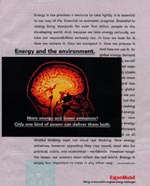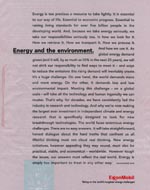|
|
||||||||
| By A.D. Freudenheim |
15 May 2005 |
|||||||
|
I love The Economist magazine, and I am not afraid to say so. The publication blends terrific reporting from around the world (far better, more thorough, and more nuanced than any American publication) with a classically-liberal perspective – which is to say, not the pathetic liberalism of the American label – that is extremely appealing. One area in which The Economist has been a journalistic leader, certainly notable in the U.S. and particularly given the magazine’s interest in and natural audience drawn from the business community, is environmental reporting. Here, the publication has consistently advocated for smarter and more aggressive environmental policy, from what one might call a common sense perspective in the Teddy Roosevelt vein: we need the earth to be habitable, and we want to enjoy its benefits; therefore protecting it must be a priority for all nations. How odd then that, for the second time in as many months, The Economist has agreed to run one of the worst advertisements I have yet seen – an ad I can only describe as both stupid and oddly cynical. As shown below, the advertisement from ExxonMobil is a full page of text with a large slug that reads “Energy and the environment.” Then, attached to the full page ad is an insert card with a picture of a human head in cross-section, showing a highlighted brain.
The focus of the ad is to sell the idea that the best thing ExxonMobil can do for the planet is bring better thinking to the whole field of energy development – and convince readers that this is, in fact, its corporate mission. The attached card similarly suggests that “only one kind of power can deliver” both “more energy and lower emissions,” and when a reader flips over the card the answer (as if it was not already clear) is provided: “brainpower.” So what’s got me riled up? Well, that insert card – a printed card on heavier, chemically-coated paper stock that says nothing more substantial than the magazine page itself already does. Is ExxonMobil really giving greater thought to “energy and the environment” when it uses more paper, not less, to get its message out, and when the additional paper is used for nothing at all except to repeat the same ad points already on the magazine page? Cleverly, the attached card might have been a postcard, something with a message on it that also gave the user a freebie – much like the postcards available in trendy bars and restaurants that also serve as ads. But ExxonMobil and its marketing agency did not get that creative. And so, instead of creating just one full page ad that holistically combines all these messages to get across their message of environmentalism, they have used more paper, and thus more trees, and also more chemicals (for the coating and the printing), not to mention the adhesive gum that keeps the postcard in place. I am not so naïve as to think of ExxonMobil as particularly environmentally friendly, regardless of what advertisements it takes out. Anyone remember the Exxon Valdez? This is an oil company, after all – one of the least eco-friendly fuels around. Nor would I have been particularly bothered by a full page ad in the magazine from ExxonMobil; I would have paid as much or as little attention as I do to most ads. But this got my attention – and not in a good way. The ad does nothing at all to reinforce the very messages that ExxonMobil has printed on the page, or that The Economist proclaims in its editorial content. ExxonMobil should be ashamed of itself – and The Economist should have rejected the ad in its current form as wasteful and unnecessary. That’s some brainpower at work. |
||||||||
|
Copyright 2005, by A.D. Freudenheim.
May not be used in whole or part without written permission.
However, you may link to this page as desired! Contact A.
D. Freudenheim for further information. This page is part of: The Truth As I See It. |
||||||||


